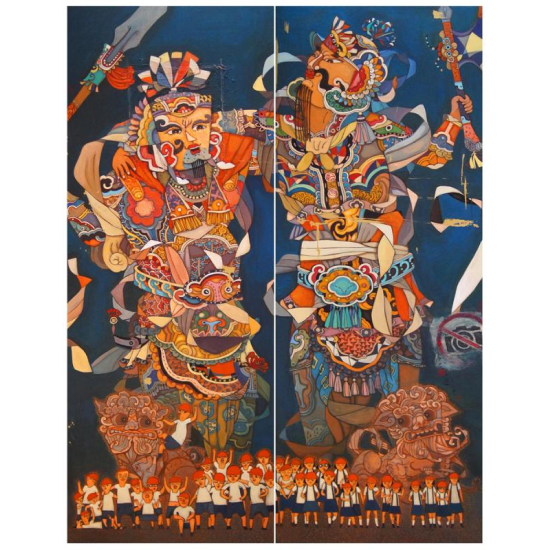本計畫「富盛印象」取「富盛」為「府城」的諧音,同時又有「富饒豐盛」的寓意。藉由10件臺南市美術館典藏的臺南特色與人文景觀,希望帶給收藏家美好的府城文化記憶。這10件作品包含了蔡草如所畫旭日東升的赤崁樓、潘元石以版畫創作臺南車站、郭柏川繪製臺南祝典武廟、陳澄波在臺南訪友時留下的〈新樓庭院〉一作、張炳堂用明亮的三原色畫出熱鬧蒸騰的〈開元寺之晨〉、許武勇獨特的切割法畫出廟會的熱鬧景像、洪顯超融合防風林意象創作而成的當代水墨作品、陳輝東用〈收穫〉傳達對辛勤工作漁民之禮讚、林智信〈嬉春〉以木雕版畫傳達樸實真摯的情感,以及新生代畫家陳盈如回憶童年時光所繪的〈大合唱〉等。
“ 富盛印象 ” takes the homophonic sound of “ 富盛 ” which represents “ 府城 ”(Tainan), while also conveying the meaning of “abundance and prosperity”. This limited edition“Tainan 400 | Flourishing Impressions”, a collaboration between Tainan Art Museum and AUO FindARTs, represents the collection composed of 10 artists, 10 mediums, 10 attitudes, and 10 architectural landscapes spanning over a hundred year. Each artwork showcases the artist‘s observations, perceptions, and descriptions of Tainan, as well as the multitude of thoughts hidden within the dimensional realms.
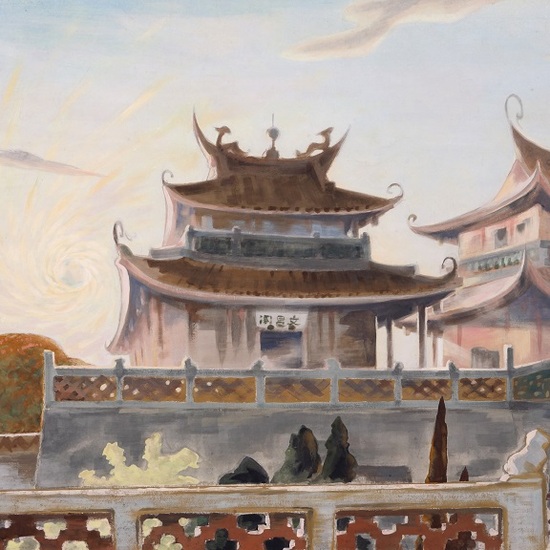
蔡草如 (1919-2007)本名蔡錦添,1953 年後改名為草如,臺南人,母親為府城名畫師陳玉峰的大姊,與知名傳統彩繪畫家陳壽彞為表兄弟。自幼隨著舅父陳玉峰學習傳統彩繪,並在1943 年赴日進入川端畫學校習畫,1946 年返臺進行傳統彩繪工作。蔡草如一生身兼廟宇民俗畫師及畫家兩種身份,他的創作秉持實地寫生與創新精神,對於自身的文化、藝術與信仰有獨特見解與嶄新詮釋,表達對家鄉人文風景的欣賞與認同。此件作品的構圖是從赤崁街仰眺赤崁樓,於夏日清晨捕捉旭日東升時刻之情景,文昌閣聳立畫面正中央,成為畫面焦點,朝陽宛如急速旋轉的火球一般,從文昌閣左後方綻射出漩渦狀金芒,其逆光照射的光影氛圍,籠罩整個畫面,或許為了凸顯光影效果之考量,這件作品的線條表現機能頗為低調,利用色彩和明暗之變化來烘托光影效果。也由於清晨的逆光表現,因而依造現場視覺經驗而降低彩度及景物細節之清晰度。左側翹脊者是蓬壺書院建築體,遠景盛開鳳凰花處是成功國小,也點出了夏日時節。此作品同時紀錄了戰後初期赤崁樓之原貌。
TSAI Tsao-Ju learned to draw from life with ink paintings from KOMATSU Hitoshi, IWATA Mitsubo and KAWABATA Gyokusetsu, which set the tone for his later works that he also brought to Taiwan. In 1964 he established the Tainan City Chinese Painting Research Society and organized several life drawing events using ink. The artwork titled The Chikan Tower provides a glimpse of a visit to the city gate and an old temple, and is likely a draft for his acrylic painting Sunrise at Chikan Tower. Both The Chikan Tower and Sunrise at Chikan Tower were created while Tsai was standing by the “Penghu College” on Chikan Street, facing east toward the Wenchang Pavilion in the distance. TSAI Kuo-Wei, the son of the artist, generously provided this work. It is helping the museum reconstruct the creative trajectory of TSAI Tsao-Ju, an older-generation artist.

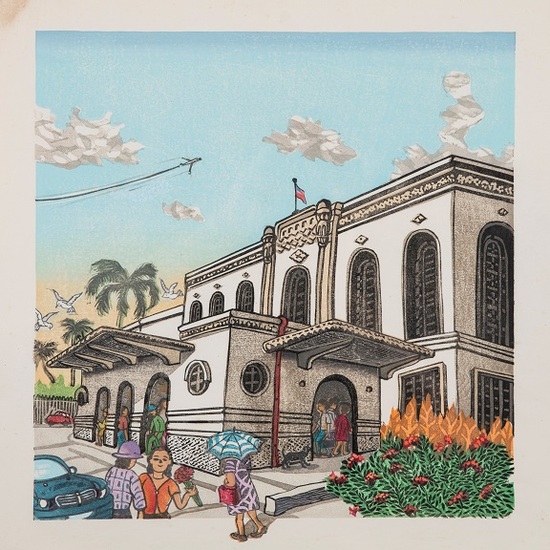
潘元石(1936-2023)1936年出生於臺南,幼時生長於臺灣版印重鎮的米街(今新美街)與萬福庵附近,對於版畫創作情有獨鍾。長期投入特殊兒童教育、藝術教育推廣及藝術人才培育,對臺南藝術人文發展和美術社會教育影響甚鉅。潘元石以木板刻印為主要的藝術表現,創作主題緊扣其熱愛的府城。不論是日常生活記憶的場景,或是府城特有的古蹟文物,透過他的巧手,都轉化成印刻作品裡帶著豐富色彩的線條和圖形。
PAN Yuan-Shih, born in 1936 and grew up at Rice Street in Tainan (Now Xinmei Street), was deeply attracted by printmaking. He has long engaged in art education for exceptional children, promotion of art education, and cultivation of art talents. As a result, Pan has had a major impact on art development and art social education in Tainan. Printmaking has remained the major artistic presentation in Pan’s life. The subject matter of his prints are also closely associated with Tainan City, where he beloved. Whether scene in daily life memories or historical sites and artifacts that are exclusively of Tainan City, those images are transformed into outlines and graphics with rich palette presentation.

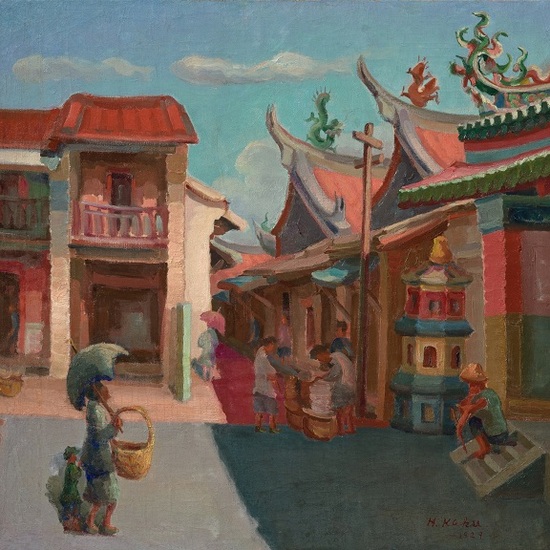
郭柏川(1901-1974)出生於臺南打棕街,1928 年曾遠赴日本東京美術學校師事岡田三郎助,並積極參與赤島社、光風會和臺展。他跟著岡田老師學習時興的外光派,注重光影寫實,以及畫面上幾何化的造形結構,由筆觸及顏料質感建構出空間深度。1937 年由日本赴中國,並任教於北平師範大學和北平藝專。1939 年梅原龍三郎應邀至中國擔任評審,由郭柏川接待,兩人在北京四處寫生,梅原在宣紙上畫油畫的特殊作法,也啟發了郭柏川日後的創作。這件〈臺南祀典武廟〉渾厚有力的短筆觸,在畫布上堆疊低彩度的色塊,表現出當年臺灣樸實的風土民情。廟埕前偌大的陰影將畫面從中一分為二,大膽的構圖所帶來的光影效果,讓整個畫面更為活絡生動。手持洋傘遮光漫步著的婦人,對應著在陰影處納涼休憩的市井小民和販賣下午點心的小攤販,輕鬆點出臺南悠閒的午後時光。
Born in Dazong street of Tainan, KUO Po-Chuan moved to Japan in 1928 to learn Western paintings after being accepted into the Tokyo University of the Arts. He learned under the tutelage of Okada Saburōsuke (1869-1939) and exhibited his works by participating Koufuukai and Akajimasha. He learned the Pleinairism (i.e., Japanese contemporary Impressionism,) art trend of the time with Okada Saburōsuke. He focuses on the expression of light and shadow; his paintings also have a geometric composition that realistically expresses spatial depth. In 1937, KUO moved to China and taught in Beiping Normal University and Beiping National Art School. In 1939 KUO met Ryuzaburo Umehara and inherited Umehara’s technique of using oil on Xuan paper.

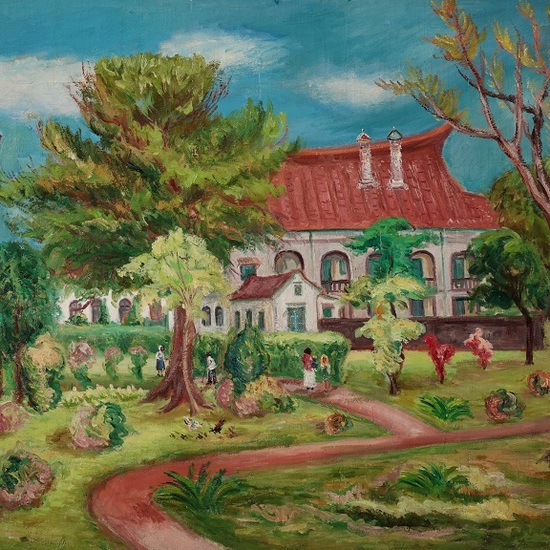
1941年太平洋戰爭爆發後,陳澄波避居郊區鄉間,好友廖繼春當時任教於臺南長老教會中學,於是陳澄波就以「臺南神學院」畫了一系列的作品,此畫即其中之一。作品以顏色分成三個部份,天空、建築物、以及前方綠地;藍色的天空還飄著幾朵白雲,下方的建築物為當時的甘為霖故居,屋頂以傳統建築型式飛簷紅瓦來呈現,屋頂上有兩處煙囪,顯示這可能非為教室,比較有可能是宿舍區,下方連兩層的連拱走廊,相較於當時大多為土角厝或是單層的磚造房子,是為新式的西式建築,符合教會學校的氛圍。在甘為霖故居的前方被樹木遮住的建築應為臺南神學院。臺南神學院源於長老教會蘇格蘭宣教師巴克禮牧師(Thomas Barclay)1877年創立之「大學」(Capital College),1903年2月新校舍本館落成,建築至今尚存。在畫面左前方的建築則為巴克禮牧師館。(資料來源:陳澄波基金會https://chenchengpo.dcam.wzu.edu.tw/Education_Workref.php?wid=23)
After the outbreak of the Pacific War in 1941, Chen Cheng-po retreated to the countryside outskirts. His good friend, Liao Ji-chun, was teaching at the Tainan Presbyterian Church Senior High School at that time. As a result, Chen Cheng-po painted a series of works titled "Tainan Seminary," and this painting is one of them. The artwork is divided into three parts: the sky, the buildings, and the green area in the foreground. The blue sky is adorned with a few white clouds. The buildings below depict Gan Wei-lin's former residence, featuring traditional architectural elements such as flying eaves and red tiled roofs. There are two chimneys on the roof, indicating that this might not be a classroom but more likely a dormitory area. Below, there are two levels of connected arched corridors, which, compared to the mostly traditional courtyard houses or single-story brick buildings of that time, represent a more modern Western-style architecture that aligns with the atmosphere of the church school. The building obscured by trees in front of Gan Wei-lin's former residence is Tainan Seminary. Tainan Seminary was established in 1877 as the "Capital College" by Scottish missionary Reverend Thomas Barclay of the Presbyterian Church. The main building of the new campus was completed in February 1903 and still stands today. The building in the front left of the painting is the Reverend Barclay's residence.

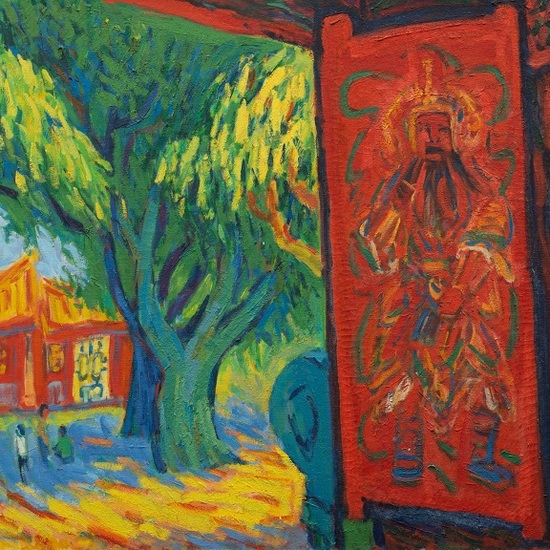
張炳堂( 1928-2023 )生於臺南,時年十五歲即以〈廟庭之晨〉一畫在第五屆「府展」綻放光彩,成為有史以來入選官辦展最年輕的臺灣畫家。張炳堂擅長以大膽的色塊、寫意的線條來刻畫風景,臺南的古蹟、運河及寺廟是他筆下常見的主題。早年他不喜混濁的中間色,擅長以濃烈的原色、簡練的線條與快速的筆觸,完成富有個性與生命力的作品。郭柏川關於「中國色彩」的思考,使張炳堂得到題材與原色呼應的啟迪,而後廟宇的紅牆與鮮黃靛藍的琉璃瓦,便成了張炳堂的標誌風格。〈開元寺之晨〉給人炙熱而顏色鮮麗的感受,畫家捕捉了光與大氣的流動本質,以濃烈飽和的三原色來描寫南臺灣的地方色。
CHANG Ping-Tang was born in Tainan, displaying his self-confident brilliance at the 5th Taiwan Governor-General Exhibition with the work Morning in the Imperial Court at the young age of 15, making him the youngest Taiwanese painter ever to be nominated at an official government exhibition. CHANG was one of the first Fauvist painters in Taiwan and he often focused his subject matter on historical sites, canals and temples, being particularly skilled at using bold colored blocks and freehand lines to depict landscape scenes. In his early years, the artist disliked blurry intermediate colors and was very adept at using heavy primary colors, succinct lines, and rapid brush strokes to complete works replete with individualism and vitality. Reflections on “Chinese colors” in the works of KUO Po-Chuan enlightened CHANG as to the complementary nature of subject matter and primary colors and thereafter temples with red walls and bright yellow and indigo glazed tiles became a stylistic constant in his works. In Morning of Kaiyuan Temple one can feel the heat and bright colors, while the artist captures the flowing essence of the light and atmosphere, using three strong and saturated primary colors to depict the local hues of southern Taiwan.

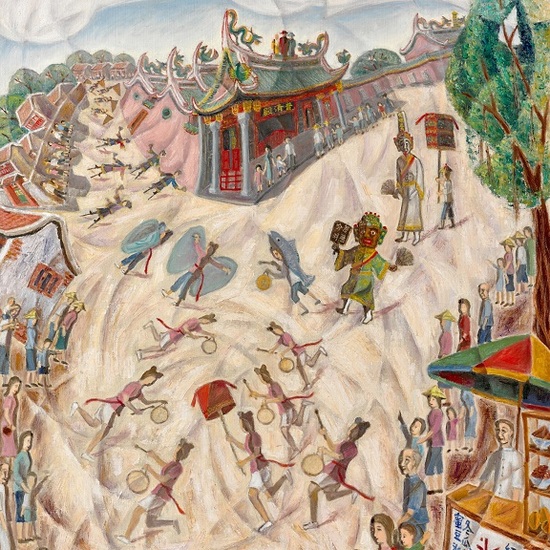
許武勇(1920-2016)出生於日治中期的臺南,畢業自臺北高等學校(今國立臺灣師範大學),藝術上師事鹽月桃甫。1941 年前往東京帝國大學(今東京大學)就讀醫科,並同時向樋口加六學習素描,於此期間入選獨立美術協會展。戰後考取公費留學美國加州大學,除參訪美國博物館研習作品外,亦在美舉辦個人展覽。返臺後於各地行醫外,創作不輟,入選省展與臺陽展20 餘年,是開創臺灣美術立體派重要的先驅畫家。1987 年自醫界退休,成為專業藝術家。許武勇以東方元素及充滿個人幻想的超現實主義融會的「羅曼主義」風格,企圖脫離寫實主義的束縛,用繪畫啟發善與美的和諧理念。
Born in Tainan under the Japanese Rule period, HSU Wu-Yung graduated from the Taihoku Higher School (now the National Taiwan Normal University) and studied art under Shiotsuki Tōho. In 1941, he enrolled in Tokyo Imperial University (now the University of Tokyo) to study medicine; at the same time, he studied sketching under Higuchi Karoku, and during this period, his work was chosen to be shown at the Dokuritsu Fine Arts Society Exhibition. After the Second World War, he received a scholarship to study at the University of California. In addition to visiting museums in the United States to study the works of different artists, he also held his own exhibitions there. After returning to Taiwan, he practiced medicine in various places in Taiwan, yet he continued to paint, and had his work shown at the Provincial Exhibition and the Taiyang Exhibition for more than 20 years to become an important pioneer in Taiwan’s Cubism. He retired from the medical profession in 1987, after which he became a professional artist. He integrated Eastern elements and a Romanticism style full of surrealism to escape the constraints of realism. He used his paintings to inspire the harmonious concepts of goodness and beauty.

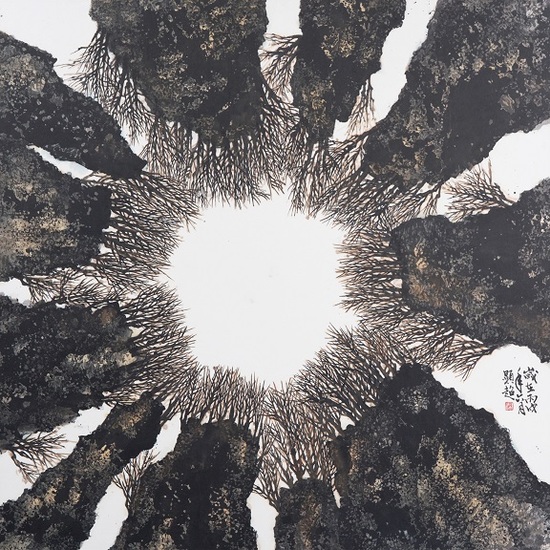
洪顯超(1962-2010)雲林人,國立臺灣師範大學美術學系博士班,曾任教於國立臺南大學美術系,在臺南藝術界深耕多年。主張以傳統中國繪畫美學特質為基礎,觀察臺灣自然人文環境並集合時代精神、抒發個人情思,特別是從現實生活中旅遊、觀察、寫生等來建立自己的審美觀,在臺灣西南海岸的自然人文中獲得創作的靈感與反映心靈意象。藝術家將臺灣山林的情境轉化為內在精神的表達,以傳統水墨語彙詮釋臺灣山林之意象,展現出傳統與現代相互對話的水墨新境。
LHUNG Hsien-Chao is from Yunlin and has a Ph.D in Fine Arts from National Taiwan Normal University. He has taught in National University of Tainan Department of Fine Arts and worked numerous years in Tainan. He uses traits of Chinese painting aesthetics as the basis for his work. HUNG observes Taiwan’s natural and cultural environment, mixing the spirit of the period and finding inspiration through his emotion, especially from travels and life sketches of the coastlines of South-eastern Taiwan. This other-worldly angle transforms the mountains of Taiwan into an expression of one’s inner spirit, displaying the conversation between tradition and contemporary ink.


陳輝東 1938 年出身於臺南,為目前臺灣畫壇在人物肖像、風景、靜物等領域皆能卓然有成的全方位藝術家。初期作品充滿高度實驗精神,表現、抽象與寫實構成其探索向度,加以素來關心世界美術思潮、一度客居歐美,不斷反思與內化,逐步形塑成屬於自身所特有的精神性寫實主義風格。〈收穫〉一作藉由魚隻的動感和勞動者使勁拖網的畫面,共同描繪出臺灣勞動力的熱情和藝術家的人文關懷。
CHEN Huei-Tung, born in Tainan 1938, is a celebrated all-round artist in portrait, landscape, and still life painting. CHEN was highly experimental in his early career, urging him to later explore expressionism, abstract art, and realism. Moreover, by paying close attention to international trends in the art world and having sojourned in Europe and the United States, the artist has been constantly reflecting on his thoughts and internalizing past experiences, eventually developing a unique painting style of spiritual realism. The painting "Harvest" depicts the dynamic movements of fish and the strenuous efforts of laborers hauling nets, portraying both the passion of Taiwan's workforce and the artist's humanistic concern.


林智信(1936-)出生於臺南歸仁,今年88歲,為戰後藝術家中創作土地與結合生活的傑出創作者,其創作中四季童玩系列包括《嬉春》、《歡夏》、《爽秋》、《暖冬》等,作品呈現濃濃的古早味,刻畫農村孩童天真與稚氣模樣,以及早期台灣農村情景與古早童玩的樂趣。《嬉春》呈現春天喜氣洋洋,放鞭炮、穿新衣小孩子興高采烈的玩紙龍。
Lin Chih-hsin was born in Guiren, Tainan. At the age of 88, he is an outstanding artist among post-war artists who integrate land and life in their creations. His Four Seasons Childhood Play series includes works such as "Joyful Spring," "Cheerful Summer," "Vibrant Autumn," and "Warm Winter." His artworks exude a strong sense of nostalgia, depicting the innocence and childishness of rural children and capturing the joy of early Taiwanese rural scenes and traditional childhood games. "Joyful Spring" portrays the vibrant atmosphere of spring, with children enthusiastically playing with paper dragons, setting off firecrackers, and wearing new clothes.

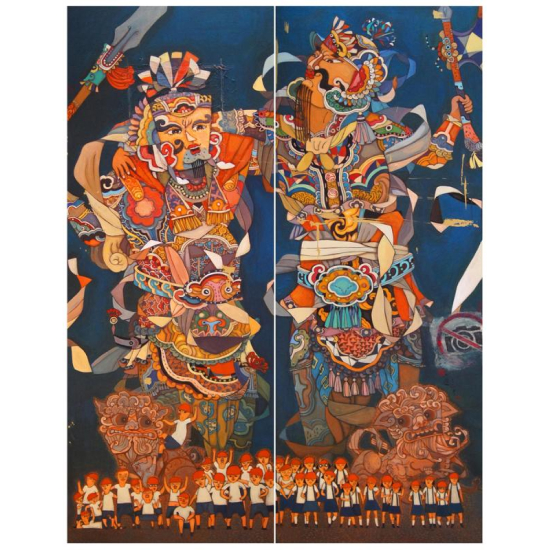
陳盈如 1983 年出生於臺北,2012 年畢業於國立臺灣藝術大學書畫藝術學系碩士班。她的作品題材經常是由生活中遇到的事件、故事為主軸,周遭的人、事、物做為主角,並結合臺灣民俗、中國傳統,再透過第三者的角度以獨立和純粹的心境,在作品中表達了對所處環境的感受、經歷。擅用「心、意」在畫作中融入自我想像、天馬行空的潛意識,豐富的色彩、幽默逗趣的造型,使得畫面構成了屬於自我的高度顯意識。本館典藏〈大合照〉的創作靈感源自藝術家童年時期到臺南外婆家拜訪的記憶。假期間陳盈如隨著長輩到廟宇拜拜的童年回憶,引發她將各式各樣的門神造型,以逗趣幽默的手法表現在繪畫創作上。畫面中參加戶外教學的學生們正站在廟門前拍下「到此一遊」的合照,被調皮的小孩騎著的石獅,似乎露出生氣的表情呢!
Chen Ying-Ru was born in Taipei in 1983 and graduated with a Master’s Degree from the Department of Calligraphy and Painting Arts at National Taiwan University of Arts in 2012. CHEN’s works often focuses on events and stories encountered in real life, with people, events, and objects around her playing the main roles. This is then combined with such Taiwanese folk customs or Chinese tradition and presented from a third person perspective as an independent and pure mindset, expressing through painting the artist’s feelings and experience of the environment in which she finds herself. CHEN is particularly adept at using “mind and thoughts,” imbuing paintings with her own imagination and soaring subconsciousness, rich colors, humorous and amusing shapes, so these works are to a high degree built on the self-consciousness of the artist. The creative inspiration for the works Group Photo and Peace Time comes from the artist’s childhood memories of visiting her grandma’s home in Tainan. During the school holidays in Tainan, she frequently went with adults to temples to pray, which later led her to depicting the various door gods encountered through amusing and appealing methods. In the painting a group of students are on a field trip ready to take a group photo, one child is even riding on a stone guardian lion, which looks annoyed!
